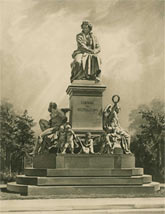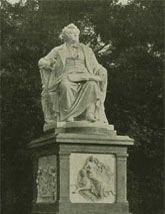1878 - 1880
Caspar Zumbusch's Beethoven monument - II
The Beethoven monument by Caspar Zumbusch was not the first monument for a Vienna musician. In 1862, the Vienna Male Choral Society had a statue erected for Franz Schubert. It was designed by artists Theophilus Edvard von Hansen (1813-1891) and Carl Kundmann (1838-1919) and unveiled in 1872.
In the 1870s Vienna felt a need to finally set up a monument for Ludwig van Beethoven and held a competition.
Well-known artists - particularly Franz Liszt and Johannes Brahms supported the project with generous financial
contributions so that the monument could be presented to the public on May 1st, 1880.
The new and special features of Carl Zumbusch's monument become particularly clear when comparing it to the
slightly older Schubert monument from Karl Kundmann. Kundmann also presented the composer in a sitting position
on a high pedestal and wrapped in a large coat. However, his monument is less pompous and conveys a more private
atmosphere. This is mainly due to the pedestal's design which, for the Schubert monument, was decorated with
reliefs, whereas the pedestal of the Beethoven monument features vivid sculptures.
Therefore, Caspar Zumbusch's monument represents the strong self-confidence of the German and Austrian upper
middle classes which regarded themselves as the main supporters of German art during the second half of the 19th
century. In accordance with this conviction, the monument should not only honour an important person but also
adorn the city, as a newspaper article from 1877 says.




